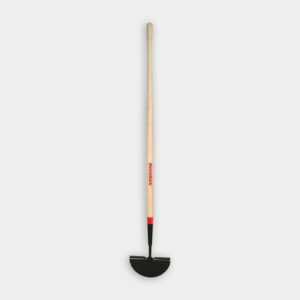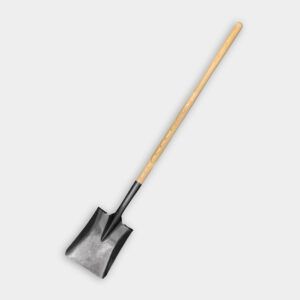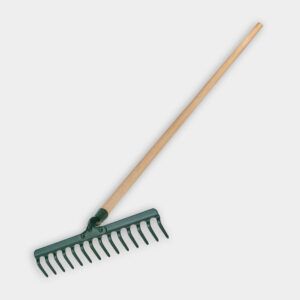We may be compensated if you purchase through links on our website. Our team is committed to delivering honest, objective, and independent reviews on home products and services.
Construction projects can leave your lawn looking worse for wear. From tire ruts to compacted soil and debris, the aftermath of building work often requires some serious lawn rehabilitation. Fortunately, with the right techniques and tools, you can restore your grass to its former glory. This Old House landscape contractor Roger Cook explains how to repair a badly rutted lawn without replacing all the grass in the above video. Read on for a step-by-step guide.
Assessing the Damage to the Lawn
Before diving into repairs, evaluate the extent of the damage to your lawn. This assessment will help you determine the best course of action and the materials you’ll need. Understanding the type and extent of damage helps you select the most effective repair method and allocate the proper resources.
Common Types of Construction Damage
Construction can harm your lawn in several ways:
- Damaged or dead grass from material storage can suffocate plants.
- Debris, such as gravel or stone dust, is left behind.
- Soil compaction from foot traffic and equipment makes it difficult for grassroots to grow.
- Tire ruts from heavy machinery can compact the soil and displace grass.
Determining the Repair Method
The severity of the damage will dictate your repair approach:
- Minor damage: May only require raking, topsoil addition, and reseeding to encourage new growth.
- Moderate damage: Might need soil aeration, topdressing, and overseeding, allowing the lawn to breathe.
- Severe damage: This could require removing and replacing damaged turf to create a uniform lawn appearance.
Gather Tools
You’ll need the following tools for lawn repairs:
- Garden rake
- Lawn edger
- Square shovel
Repairing Tire Ruts on Your Lawn
Tire ruts are one of the most common forms of construction damage to lawns. Cook demonstrates an effective method for addressing this issue without replacing the entire lawn.
Removing the Damaged Turf
First, remove the damaged turf:
- Use a gas-powered sod cutter to slice the sod free from the soil along the tire ruts. This allows you to access the compacted soil beneath.
- Cut the severed strips of sod into 12-inch-long pieces using a manual lawn edger for easier handling.
- Remove the sod pieces with a straight-blade shovel and set them aside for later use. This keeps the sod viable for reinstallation.
Preparing the Soil
Once you’ve removed the damaged turf, it’s time to address the compacted soil beneath:
- Use a rotary tiller to break up and loosen the compacted soil in the tire ruts, promoting healthy root growth.
- Rake the tilled soil smooth and level, making sure it’s even with the surrounding lawn, which creates a seamless transition.
Replacing the Turf
With the soil prepared, you can now replace the original grass:
- Set the sod pieces back into place, checking that they fit tightly together to minimize gaps.
- Water the area immediately after replacing the turf to encourage root growth and establishment.
Addressing Other Lawn Damage
Construction projects often leave behind more than just tire ruts. Here’s how to tackle other common issues effectively and efficiently.
Removing Debris
Start by removing the debris:
- Use a shovel and rake to systematically remove gravel, rocks, stone dust, and other debris left behind by construction work.
- Dispose of the debris properly or repurpose it for other landscaping projects, adding value rather than waste.
Improving Soil Quality
To give your lawn the best chance of recovery:
- Fill damaged areas with a rich mixture of topsoil and compost to improve soil fertility.
- Till the new soil mixture to integrate it with the existing soil, improving consistency.
- Rake the area smooth, making sure it’s level with the surrounding lawn to prevent water pooling.
Concealing Eyesores
Sometimes, construction leaves behind necessary but unsightly elements in your lawn. Cook offers a creative solution for dealing with a wellhead in the middle of the yard. Implement techniques to disguise or integrate these elements into your landscape design.
Creating a Mulch Bed
Here’s how to create a mulch bed:
- Design a natural-looking mulch bed that skillfully incorporates the eyesore into your overall lawn design.
- Edge the bed, following the contours of your lawn for a seamless look that blends with your existing landscape.
- Spread about 2 inches of bark mulch over the entire area and rake it smooth to uniformly cover and protect the underlying soil.
Using Decorative Elements
To further camouflage unwanted features:
- Add real weathered rocks from your property to create a natural-looking grouping that complements your garden.
- Place a realistic fake boulder over elements such as wellheads.
- Plant perennials around the rocks to improve the landscaped appearance with seasonal color and texture.
Seeding and Aftercare for a Lawn
Once you’ve addressed the major damage, it’s time to focus on encouraging new grass growth and maintaining your repaired lawn. Proper seeding and aftercare are vital to achieving and sustaining a lush appearance.
Choosing the Right Seed
Select a grass seed that matches your existing lawn and is suitable for your climate. Think about factors such as:
- Local weather patterns, choosing seeds resilient to your area’s climate challenges.
- Soil type, selecting seeds that will maximize growth potential.
- Sun exposure, checking that your seed choice thrives in available light.
- Traffic levels, picking robust varieties if the area sees heavy use.
Seeding Techniques
For best results when seeding:
- Spread the seed evenly over the prepared soil, checking for consistent coverage.
- Lightly rake the seeded area to create good seed-to-soil contact, promoting successful germination.
- Apply a thin layer of straw or seed-starting mulch to retain moisture and protect seeds from birds.
Watering and Maintenance
You should take proper care of the newly seeded areas by doing the following:
- Avoid heavy foot traffic until the new grass grows to prevent damage.
- Once the grass reaches mowing height, begin regular lawn care practices, including proper mowing and fertilization.
- Water lightly and frequently to keep the soil consistently moist but not waterlogged.
Ongoing Lawn Care
Maintenance of your lawn post-repair supports its long-term health. Ensure you do the following:
- Implement seasonal aeration and dethatching practices to maintain soil health and encourage robust growth.
- Integrate organic fertilizers into your routine to provide a steady supply of nutrients without chemical runoff.
- Regularly test the soil and adjust pH as needed to foster an environment conducive to lawn health.



